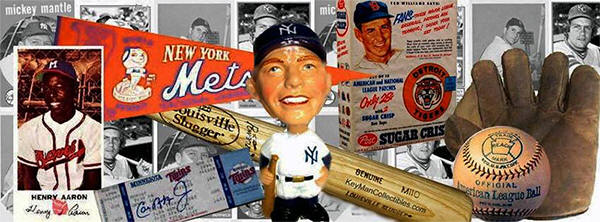In 1892
Joshua Pusey secured a patent for
the compact cardboard match, and
then sold it to the Diamond Match
Company. It took some time to catch
on, but matchbook advertising
became one of the most successful
and cost efficient adverting
mediums of all time. Reaching for a
single matchbook given away to a
patron exposes the advertisement
20-40 times. Baseball was a popular
theme to attract customers to a
product or service.
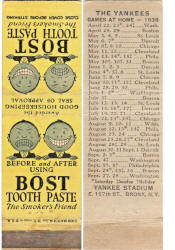 Matchbook baseball schedules
Matchbook baseball schedules
were often used by a variety of
advertisers. The idea being after
all the matches are used the
baseball fan, will keep the
schedule for their favorite team,
saving the advertising on the other
side. Distillers commonly used
matchbook schedules, distributing
them to bars where baseball fans
gathered for a drink and a smoke.
Taverns & lounges also used this
medium to promote their
establishment. At a time when
smoking cigars & cigarettes at the
game was permitted, cigarettes were
also sold at the ballpark. Some
teams printed their own
complimentary matchbook schedules,
and made them available at the
ballpark.
Matchbook Collecting
Terminology:
"Panel" - a
section of the outside of a cover
(i.e., front panel, back panel).
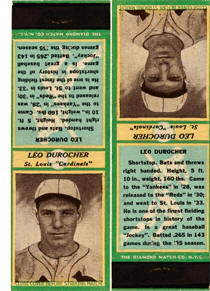
The Diamond Matchbook Co. produced four sets of
baseball card like player matchbook
covers from 1934-1937. The
1935-1936 Diamond matchbook covers
measure about 1-1/2 x 4-1/8. The
front of the matchbook feature a
sepia tone baseball player picture
pose. The borders can be found in
red green, or blue. This issue does
not feature the team name on the
back below the players name, as
with other Diamond matchbook covers
issued later. The back also
features a short career bio, and
the inside is blank. Baseball Stars
of the day featured in this set
includes; Frankie Frisch, Dizzy
Dean, Mel Ott, Paul Waner, Casey
Stengel, and many other HOF players.
Matchbook Collecting Terminology:
"Full Book" - cover with
matches; most collectors strip the
matches out; hence, "match cover"
the foldable cardboard covering for
the matches in a matchbook; also
used to describe a matchbook after
the matches have been "stripped"
out.
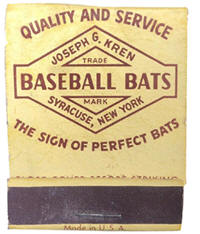
Established in 1913, the KREN BAT
Co. traces it's roots to a little
shop in the back of Joseph G.
Kren's home in Syracuse N.Y. Early
on Kren gained a reputation among
major league ballplayers for
turning out high grade baseball
bats. Legends such as Babe Ruth,
Lou Gehrig, Rogers Hornsby and
Frankie Fritch used Kren Bats
during its heyday. The small bat
company gave Louisville Slugger a
run for its money, making sometimes
upwards of 100,000 bats in a year.
This book of matches which was
produce in 1939 features the
official 1839-1939 Baseball
Centennial logo. The saddle of the
matchbook which was manufactured by
the Federal Match Corp. reads;
"MATCHES TO STRIKE, KREN BATS TO
HIT."
Matchbook Collecting Terminology:
"Saddle" - the portion of a cover
between the two central folds; it
divided the front and back panels.

In 1950 Austin Nichols issued a set
of 6
sports themed advertising
matchbooks to promote their new
line of Pedro's Rum. The Series
titled “Names to Remember” which
included; Boxers, John L Sullivan,
Robert Fitzsimmons, James J. Corbet,
Football's Knute Rockne, and
baseball stars, Christy Mathewson -
Ace Pitcher N.Y. Giants, and John
McGraw - Manager N.Y. Giants. Each
sports star is depicted with his
name to the right, and a short
career highlight note. Christy
Mathewson "Won 3 games against the
Phila, Athletics in 1905 World
Series. Was noted strike-out
artist." John J. McGraw "His teams
won 10 National League pennants and
three World's Series. He was a
leader!"
Matchbook Collecting
Terminology: "Safety
First" - old footer used by several
companies in 1920s and 1930s.
(some examples in the 1940's)
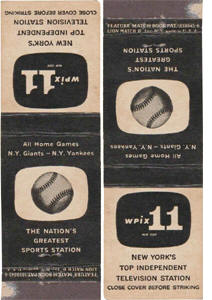
WPIX channel 11 New York, first
signed on the air, June 15, 1948.
Twenty-one days later WPIX aired
their first baseball game between,
the New York Giants and the
Brooklyn Dodgers. The station first
aired Giant games in 1949 and the
Yankees in 1951. After 9 seasons on
WPIX, the Giants moved to the West
Coast, and the station quickly
signed a record-breaking contract
with the Yankees to televise over
140 ball games. The contract for
over 400 programming hours was at
the time the largest single time
sale in the history of the medium.
Done in a black & White TV format;
the front of this
'51-'57 WPIX
matchbook made by the Lion Match
Co. features the "WPIX11 New York"
television logo.
Matchbook Collecting
Terminology: "Feature" is
a Lion matchbook trademark for
covers with pictures, and or
printing on the match sticks.
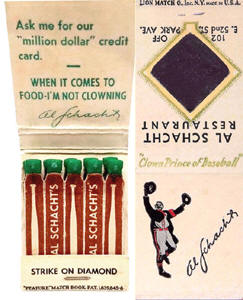
Al Schacht was a Major League
pitcher for the Washington Senators
from 1919 to 1921. He later became
a 3rd base coach, and his comedic
antics from the coaching lines with
fellow Washington coach Nick
Altrock, earned him the nickname of
"The Clown Prince of Baseball." Al
Schacht opened a Restaurant in, New
York City in Sept. of 1942. It soon
became a popular destination for
local sports stars and celebrities.
This
Al Schacht Restaurant advertising
matchbook, was manufactured by
the Lion Match Company, famous for
their patented match sticks which
were made wider to feature
artistically printed designs on
them. The colorful green tip match
sticks here feature baseball bats
alternated between the name of Al
Schacht. The back features an
"odd-striker" in the shape of a
baseball diamond.
Matchbook Collecting Terminology:
"Odd-Striker" - Lion
trademark for covers with striker
in an unusual location and shape;
1942- 1962.
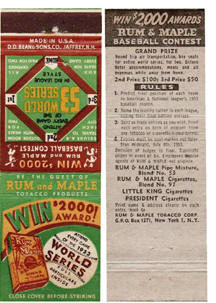
In 1953 the
Rum & Maple Tobacco Corporation
advertised a matchbook baseball
contest to promote their line
of tobacco products. The Grand
Prize winner won; round trip air
transportation, box seats for the
entire 1953 World Series for two,
deluxe hotel accommodations, meals
and all expenses while away from
home. The 2nd prize winner received
$100. and $50. went to the 3rd
prize winner.
The contest rules: 1- Predict final
position of each team in American &
National leagues 1953 baseball
season. 2- Name the leading batter
in each league, listing their final
batting average. 3- Send as many
entries as you wish. Print each
entry on back of wrapper from any
tobacco or cigarette listed (above)
4- Entries must be post marked not
later than midnight, July 4thm
1953.
The New York Yankees beat the
Brooklyn Dodger in the 1953 World
Series, for the teams 5th straight
title. (1949-1953) Washington
Senator Mickey Vernon won the AL
batting title with a .337 average.
Brooklyn Dodger Carl Furillo won
the NL batting title with a .344
average.
Matchbook Collecting
Terminology: "20-Strike"
(30 or 40) - generic term for
covers with 20 matches, 30 matches,
40 matches, or that sized cover.

Intended to be mailed in to request
information on opening an account,
this over-sized
Trust Company of North America
adverting matchbook doubles as
a postcard. When opening a savings,
special or commercial checking
account with $25.00 or more, you
may obtain two reserve seat
tickets. The inside cover mentions;
"Obtain TWO TICKETS to see your
favorite major League Team play
ball at either: EBBETS FIELD, POLO
GROUNDS, YANKEE STADIUM, for any
home game during the 1957
season..." The following panel has
the postcard form portion of the
matchbook. The back has the
Business Reply Card "Postage paid"
permit and Addressee.
Matchbook Collecting
Terminology: "Poster
Feature" - Lion Match Co. trademark
for its postcard-width covers, AKA
"Giant Feature" match book.
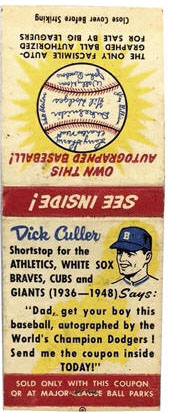
The Autographed Ball Company was
founded in 1947 by Richard B.
(Dick) Culler in High Point, North
Carolina. Culler played baseball in
the major leagues from 1936 to
1949, for the Philadelphia A's,
Chicago White Sox, Boston Braves,
Chicago Cubs, and New York Giants.
Dick Culler had invented a
technique to stamp facsimiles of
players' signatures on baseballs,
so team-autographed balls could be
mass-produced. It allowed a
baseball to be hand-stamped with a
spherical stamp six times, once for
each panel on the ball.
The front panel of the
matchbook illustrates a 1959 LA
Dodgers autograph baseball with
Duke Snider and Gil Hodges on the
sweet spot. The back depicts Dick
Culler wearing a Boston Braves
baseball cap, and reads; "Dick
Culler Shortstop for the Athletics,
White Sox, Braves, Cubs, and Giants
(1936-1948) Says: "Dad, get your
boy this baseball, autographed by
the World's Champion Dodgers ! Send
me the coupon inside TODAY!"
Matchbook Collecting
Terminology: "Pressing" -
the process of flattening stripped
covers, often in some sort of
vise-like device.
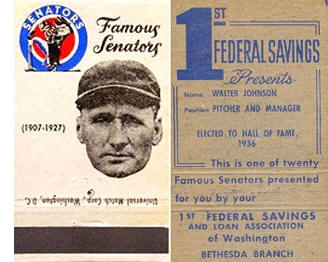
In 1959 the 1st Federal
Savings and Loan Association of
Washington D.C., issued a set of
20,
baseball series advertising
matchbooks named "Famous Senators."
The matchbooks feature "famous
Senators" of the 20th century. The
outer-back panel has a Black and
white player portrait photo, with
the (years) associated with the
team, to the left, the Washington
Senators team logo above, with
"Famous Players" to the right.
On the inside, the "1st Federal
Savings and Loans presents" the
"Name" of the Player pictured on
the front, "Position" and a tidbit
about the player such as lifetime
batting average or as with Walter
Johnson "Elected to Hall of Fame,
1936, followed by "This is One of
Twenty." Key players include Walter
Johnson, Sam Rice, and Harmon Killebrew.
When the Franchise moved to
Minnesota the same format was used
for the 1961 Twins.
Matchbook Collecting
Terminology: "Full-Length"
- cover which has the design/text
running the full length of the
cover; there are two types: 1)
horizontal Full-length; 2) vertical
Full-length

